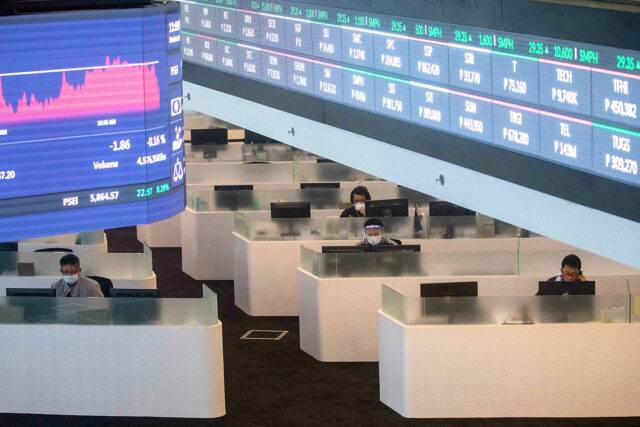Local stocks slump nearly 4% on selling pressures

PHILIPPINE SHARES declined further on Tuesday on selling pressures amid Wall Street’s decline and the aggressive stance of the US Federal Reserve that pushed the peso lower.
The benchmark Philippine Stock Exchange index (PSEi) lost 239.47 points or 3.82% to close at 6,020.07 on Tuesday, while the broader all shares index dropped by 107.06 points or 3.2% to 3,234.23.
This is the PSEi’s lowest close since 6,019.26 on Oct. 19, 2020, or nearly two years ago.
“Selling pressure is strong across all markets due to the hawkish stance by the Fed to bring down the inflation rate to 2%,” Mercantile Securities Corp. Head Trader Jeff Radley C. See said in a Viber message.
“The local bourse plummeted by 239.47 points or 3.83% to 6,020.07 amid recession fears abroad and negative sentiment at home, closing at the bear market territory based on the market’s February 2022 peak,” Philstocks Financial, Inc. Research Analyst Claire T. Alviar said in a Viber message.
Mr. See explained that “when the market falls at least 20% from their high [7,552.20 in February], it is marked as a bear market territory which happened to the US market last week.”
“The market sell-off resumed with local shares following the equity sell-off stateside on the back of an aggressive Federal Reserve and surging interest rates, which in turn have roiled currency markets,” Regina Capital Development Corp. Head of Sales Luis A. Limlingan said in a Viber message about the sell-off in US, Europe, and Asian markets.
Wall Street slipped to a bear market on Monday, with the S&P 500 and Dow closing lower as investors fretted that the US Federal Reserve’s aggressive campaign against inflation could throw the US economy into a sharp downturn, Reuters reported.
The Dow Jones Industrial Average fell by 1.11% to end at 29,260.81 points; the S&P 500 lost 1.03% to 3,655.04; and the Nasdaq Composite dropped by 0.6% to 10,802.92.
Ms. Alviar said that “at home, investors digested the impact of Super Typhoon Karding in Luzon as well as the further weakening of the peso.”
“Investors were worried about inflation as it may get pressured by the recent typhoon. This may also exacerbate our food supply shortages which may lead to higher inflation,” she said.
On Tuesday, the peso closed at P58.99 versus the greenback, dropping by 49 centavos from its P58.50 finish on Friday, data from the Bankers Association of the Philippines showed.
The local unit has weakened by 15.66% or P7.99 from its P51-a-dollar close last year.
All of the sectoral indices closed lower on Tuesday. Holding firms lost 278.09 points or 4.58% to close at 5,787.96; financials went down by 66.54 points or 4.29% to 1,483.43; property dropped by 106.17 or 3.92% to 2,602.27; industrials declined by 270.75 points or 2.96% to 8,868.37; mining and oil shaved off 326.54 points or 2.92% to 10,808.44; and services retreated by 35.93 points or 2.19% to end Tuesday’s session at 1,601.58.
Value turnover went up to P20.88 billion with 2.20 million shares on Tuesday changing hands from the P4.83 billion with 491.33 million issues traded on Friday.
Decliners overwhelmed advancers, 189 to 28, while 37 names closed unchanged.
Still, net foreign selling declined to P11.45 billion on Tuesday from P653.55 million on Friday.
Mercantile Securities’ Mr. See placed the PSEi’s support between the 5,400 and 5,800 levels, and resistance between 6,200 and 6,600 levels, while Philstocks Financials’ Ms. Alviar put the market’s psychological support at 6,000 and resistance at 6,400. — Justine Irish D. Tabile with Reuters
